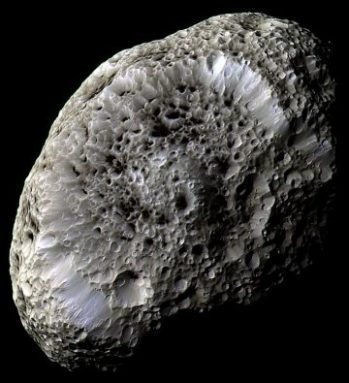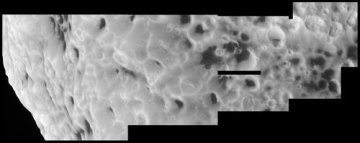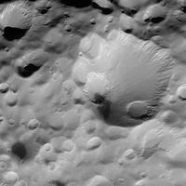Saturn’s Spongy Moon
Close-up views of Saturn's moon Hyperion reveal a strangely cratered surface that looks spongy.
Share this:
- Share via email (Opens in new window) Email
- Click to share on Facebook (Opens in new window) Facebook
- Click to share on X (Opens in new window) X
- Click to share on Pinterest (Opens in new window) Pinterest
- Click to share on Reddit (Opens in new window) Reddit
- Share to Google Classroom (Opens in new window) Google Classroom
- Click to print (Opens in new window) Print
By Emily Sohn
Saturn has a lot going for it. The planet’s spectacular rings are pretty cool. It has 31 moons, maybe more. Its largest moon, Titan, even has its own atmosphere. One of its smaller moons, Hyperion, looks like a potato and tumbles strangely as it orbits the planet.
Now, the Cassini spacecraft, which is in orbit around Saturn, has taken the first close-up pictures of Hyperion. And the view is surprising.
 |
|
Close-up images of Saturn’s moon Hyperion show a spongelike surface dotted with craters. This photo was taken when the spacecraft was 62,000 kilometers (38,500 miles) from the moon.
|
| NASA/JPL/Space Science Institute |
Hyperion is 266 kilometers (165 miles) across, and it has an irregular shape. Much of its inside is probably empty space. Scientists describe the moon as a “rubble pile.”
On Sept. 26, Cassini swooped to within 500 kilometers (310 miles) of the icy moon. The close-up images showed that Hyperion’s surface is unlike that of any of the planet’s other moons. They revealed a reddish surface dotted with craters and changed by some unknown process to give it a spongy look.
 |
|
This set of overlapping close-up images of Hyperion shows a surface covered with craters.
|
| NASA/JPL/Space Science Institute |
 |
|
Scientists would like to find out what the dark material is that fills parts of some craters on Hyperion’s surface.
|
| NASA/JPL/Space Science Institute |
Some Cassini researchers suspect that the spongelike appearance is a result of closely packed craters that were never filled in. Usually, when craters form, debris falls back into the holes. The gravity from nearby Titan, however, may have prevented that from happening.—E. Sohn
Going Deeper:
Cowen, Ron. 2005. Saturnian sponge. Science News 168(Oct. 8):228. Available at http://www.sciencenews.org/articles/20051008/fob4.asp .
Additional information about the Cassini spacecraft images of Saturn’s moon Hyperion can be found at saturn.jpl.nasa.gov/news/press-
release-details.cfm?newsID=605 (NASA).
To see a video of Cassini’s Hyperion flyby, go to saturn.jpl.nasa.gov/multimedia/videos/video-
details.cfm?videoID=98 (NASA Jet Propulsion Laboratory).
Sohn, Emily. 2005. Sounds of Titan. Science News for Kids (Feb. 16). Available at http://www.sciencenewsforkids.org/articles/20050216/Feature1.asp .
______. 2005. Unveiling Titan. Science News for Kids (Jan. 26). Available at http://www.sciencenewsforkids.org/articles/20050126/Note2.asp .
______. 2004. Saturn’s new moons. Science News for Kids (Aug. 25). Available at http://www.sciencenewsforkids.org/articles/20040825/Note3.asp .
______. 2004. Ringing Saturn. Science News for Kids (July 28). Available at http://www.sciencenewsforkids.org/articles/20040728/Feature1.asp .







